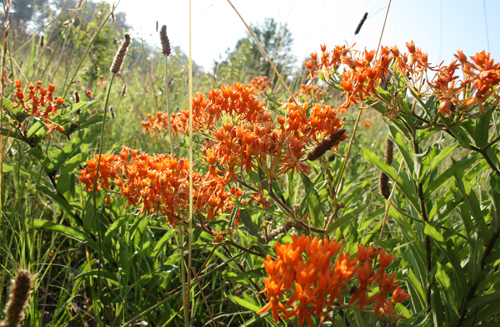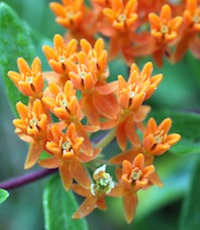Butterfly Weed is one weed you want in your landscape. It’s a butterfly magnet. The leaves are the preferred food source for the larvae of several species of butterflies, including Monarchs and the flowers provide nectar for both butterflies and hummingbirds.
When planted in full sun to partial shade, its brilliant orange flowers will brighten a perennial border and provide a striking contrast to purple coneflower, blue salvia, Persian shield and other summer favorites. Its flower colors are just one reason it was named the 2010 Georgia Gold Medal herbaceous perennial.
Butterfly Weed, Asclepisa tuberosa, is a native wildflower that has naturalized throughout much of eastern North America. It lives as far north as Ontario to New Hampshire, west to South Dakota, south to Arizona into Mexico and east to Georgia and Florida. It does best in hardiness zones 3 to 9.
It likes dry, sunny areas and can be found in small colonies in open meadows, right-of-ways and roadsides.
Butterfly Weed is a member of the milkweed family. Unfortunately, its common name has been abbreviated from milkweed to weed, which presents some negative connotations and marketing challenges since no one wants to plant a weed. But, rest assured, it is not aggressive, invasive or weedy, and it will not take over the landscape.
Butterfly Weed grows 1 to 3 feet tall and has narrow, lance-shaped leaves on stout, hairy stems that do not require staking. From June to September, flat-top clusters of bright orange to yellow-orange flowers are borne on terminal stems. They hold up well in cut flower arrangements.
Flowers are followed by spindle-shaped seed pods that are 1 to 3 inches long. When mature, they split open to release seeds with long silky hairs that float in the breezes. Gardeners concerned about the potential spread of the plant to unwanted areas can easily clip off the seed pods before they ripen to prevent seed dispersal.
Don’t be alarmed if caterpillars suddenly attack the plant and destroy its foliage. The culprits are likely butterfly larvae that depend on the plant to complete their life cycle. Defoliation doesn’t kill the plant.
Butterfly Weed can be grown from seed or root cuttings. Patience is a virtue when propagating the plant from seed because it may take 2 to 3 years to produce a flowering plant. It may be best to purchase plants from a nursery.
Two cultivars available in the trade are Hello Yellow, which produces bright yellow flowers, and Gay Butterflies, which produces a variety of flower colors ranging from yellow to orange and red.









